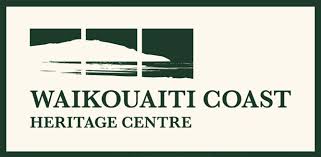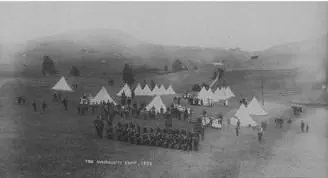Military Manoeuvres
MilitaryMANOEUVRES
Intriguing early military photo unearthed
The Waikouaiti Coast Heritage Centre has acquired an intriguing photo titled ‘Waikouaiti Camp 1892’. It shows a military camp located directly behind the former Town Hall and Council Chambers, currently the site of the East Otago Event Centre.
The photo is unusual in that most camps of the era were held near the current golf and gun clubs.
In common with most districts, from the mid 1860’s East Otago had an active volunteer movement.
Not a lot is known except what was published in various newspapers and Government papers of the time. But we do know that in October 1864 Waikouaiti volunteers attended their first training parade under Police Sergeant Burns. The following March the Waikouaiti Rifle Volunteers were formed with the commissioning of an Officer Captain, Blair Fullerton of Mount Royal, the document for which is signed by Governor Grey with a wax seal.
By 1881 the Waikouaiti Rifles had one captain, a sub-lieutenant, four sergeants, a bugler, and 45 rank and file members armed with snider rifles.
Mock Battle a crowd puller
In 1888 the North Otago Volunteers and Dunedin Hussars staged a mock battle which garnered such interest that steam trains ferried crowds of onlookers from both north and south. Unfortunately, the weather refused to cooperate and the day ended with no winner being declared.
In 1892 the camp shown in the photograph was held on the Maxwell property, which was directly behind the current Events Centre.
While in progress, there was an early demonstration of New Zealanders’ now legendary “number eight wire” mentality. The camp lacked a gun large enough and loud enough to provide a suitable display of military strength. One ingenious individual procured a blacksmith’s anvil, drilled a hole in it and poured in gunpowder. He secured the powder with a wooden peg, lit the fuse and took refuge behind a nearby hedge until the explosion – which was, by all accounts, something startling. Not something, however, that any modern armaments or health and safety official would sanction!
Sunday afternoons, following church parade, were deemed suitable for games and sports. The list of games played are reminiscent of many of a childhood: tilting the ring, sack race, Cumberland wrestling, wheelbarrow race, hop, skip and jump, putting the stone, menagerie race, tug of war, egg and ladle race, picking up stones and three-legged race.
Names mentioned in connection with the camp included Major Sutherland, Camp Major Schultze, Captain White, Lieutenants Stewart, Templeton and Colour, Sergeants Maxwell, J Diack and Bradley, Corporals H Townsend and Bell, Volunteers A Park, Volunteer A J Woolley, AH Allcock, E Aitcheson, J Cameron, W Martin, DW Mallock, J Aitcheson, J Allen and a Mr Blair. The company’s Chaplin was Rev. Lucas and the organist, a Mr Davis.
Ceremonial disbanding
In 1893 the Waikouaiti Rifles were disbanded with suitable ceremony, which took the form of a Smoking Concert. However, that didn’t end the area’s military involvement. The following year the Otago Hussars sent a party of officers to increase its numbers by recruiting 40 mounted men. These became the Waikouaiti Mounted Troop. Captain Allan S Orbell, who had been Captain of the Waikouaiti Rifles, held camps for the Hussars on his property near what is now Orbell’s Crossing.
Many of the families from this volunteer period are still in the district today. Waikouaiti Rifle Volunteer descendants who served in later conflicts are listed on the local war memorial.
There are many gaps in the information held so if you can add any details please contact the Museum via email:
Visitor Survey
Please take a moment to complete a short survey on the museum.

